Summer Research Experience for Undergraduates 2022
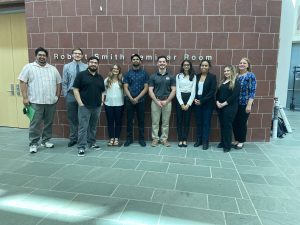
2022 Summer REU Student Information & Research Abstracts
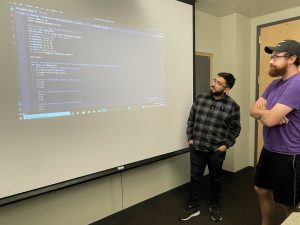 Name: Adrean Alva
Undergraduate Institution: California State University Long Beach
Major: Physics
REU Advisor: Chris Hammel, Denis Pelekhov, Mohit Randeria
Project Title: Micromagnetic Modeling
Abstract: A program was written to minimize the demagnetizing energy of a system of dipoles in a one-dimensional magnetic structure by iteratively rotating each dipole into the effective demagnetizing field vector at their location to observe magnetic domain formation. Micromagnetic modeling software was used to confirm the analytical relationship of domain wall width as a function of exchange energy and uniaxial anisotropy through numerical simulations.
Name: Adrean Alva
Undergraduate Institution: California State University Long Beach
Major: Physics
REU Advisor: Chris Hammel, Denis Pelekhov, Mohit Randeria
Project Title: Micromagnetic Modeling
Abstract: A program was written to minimize the demagnetizing energy of a system of dipoles in a one-dimensional magnetic structure by iteratively rotating each dipole into the effective demagnetizing field vector at their location to observe magnetic domain formation. Micromagnetic modeling software was used to confirm the analytical relationship of domain wall width as a function of exchange energy and uniaxial anisotropy through numerical simulations.
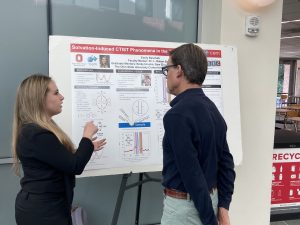 Name: Emily Baschap
Undergraduate Institution: University of Alabama
Major: Physics, Minor in Mathematics
REU Advisor: Robert Baker
Project Title: Solvation-Induced CTIST in Co3Fe2 Complex
Abstract:
Name: Emily Baschap
Undergraduate Institution: University of Alabama
Major: Physics, Minor in Mathematics
REU Advisor: Robert Baker
Project Title: Solvation-Induced CTIST in Co3Fe2 Complex
Abstract:
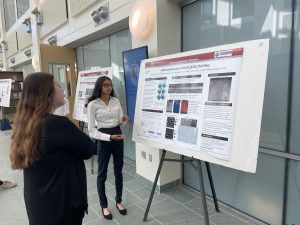 Name: Shornam Gandhi
Undergraduate Institution: University of Florida
Major: Materials Science and Engineering
REU Advisor: Jinwoo Hwang and Fengyuan Yang
Project Title: STEM Characterization of NdFeO3/SrTiO3 Thin Films
Abstract: Rare-earth orthoferrite films have unique magnetic properties due to strain and interfacial properties. As a basis for growth optimization, NdFeO3(NFO) epitaxial thin films were grown on SrTiO3(110) substrates using magnetron off-axis sputtering. To ensure epitaxial growth and minimize defects such as twinning and unwanted phases, several characterization methods (Atomic Force Microscopy, X-Ray Diffractometry, Scanning Transmission Electron Microscopy, etc.) were employed to understand the structure and quality of these films.
Name: Shornam Gandhi
Undergraduate Institution: University of Florida
Major: Materials Science and Engineering
REU Advisor: Jinwoo Hwang and Fengyuan Yang
Project Title: STEM Characterization of NdFeO3/SrTiO3 Thin Films
Abstract: Rare-earth orthoferrite films have unique magnetic properties due to strain and interfacial properties. As a basis for growth optimization, NdFeO3(NFO) epitaxial thin films were grown on SrTiO3(110) substrates using magnetron off-axis sputtering. To ensure epitaxial growth and minimize defects such as twinning and unwanted phases, several characterization methods (Atomic Force Microscopy, X-Ray Diffractometry, Scanning Transmission Electron Microscopy, etc.) were employed to understand the structure and quality of these films.
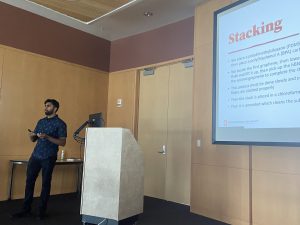 Name: Adam Jandga
Undergraduate Institution: California State University Long Beach
Name: Adam Jandga
Undergraduate Institution: California State University Long BeachMajor: Physics, Minor in Computer Science REU Advisor: Zeke Johnston-Halperin Project Title: Defect Assisted Tunneling through Different hBN Insulators Abstract: Stacks created with graphene as electrodes on each side of an hBN insulator allows the phenomenon of quantum tunneling to take place. As this research was for a summer REU program it was only about 8-10 weeks of research, so rather than research focused on tunneling through different hBN insulators, the research became more focused on flake hunting and stacking with different types of hBN. These samples are created by mechanical exfoliation, then the devices for tunneling are created using a dry transfer process. With two different types of hBN it is important to know what their differences are and why we want them. The general hBN used is commercial grade with native defects. These defects are what gives us the tunneling data we want. With a second hBN,we have a pure form of hBN that gives us more custom variables to add in our experiment.
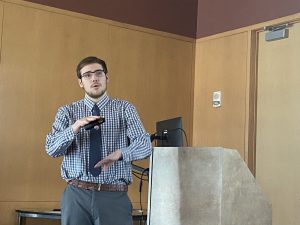 Name: Riley Nold
Undergraduate Institution: University of Alabama
Major: Physics and Mathematics
REU Advisor: Jinwoo Hwang and Fengyuan Yang
Project Title: NFO Thin Films Grown via an Off-Axis Sputtering Method
Abstract: Rare-earth perovskite thin films are known to exhibit interesting magnetic properties closely tied to their interfacial configuration. Neodymium iron oxide (NFO) thin films in particular are understudied despite the compelling interplay between their structural and electromagnetic properties. Here, NFO thin films are grown on strontium titanate (STO)substrates with a (110) orientation via an off-axis magnetron sputtering method. Atomic Force Microscopy is used to characterize the topography of both the cleaned substrates and subsequent NFO films. Films of varying thickness are studied, with X-ray diffraction and Scanning Transmission Electron Microscopy results showing epitaxial crystal growth.
Name: Riley Nold
Undergraduate Institution: University of Alabama
Major: Physics and Mathematics
REU Advisor: Jinwoo Hwang and Fengyuan Yang
Project Title: NFO Thin Films Grown via an Off-Axis Sputtering Method
Abstract: Rare-earth perovskite thin films are known to exhibit interesting magnetic properties closely tied to their interfacial configuration. Neodymium iron oxide (NFO) thin films in particular are understudied despite the compelling interplay between their structural and electromagnetic properties. Here, NFO thin films are grown on strontium titanate (STO)substrates with a (110) orientation via an off-axis magnetron sputtering method. Atomic Force Microscopy is used to characterize the topography of both the cleaned substrates and subsequent NFO films. Films of varying thickness are studied, with X-ray diffraction and Scanning Transmission Electron Microscopy results showing epitaxial crystal growth.
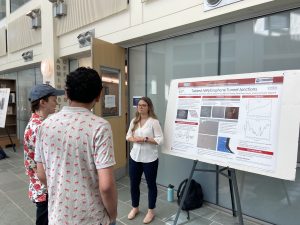 Name: Brianna Rapp
Undergraduate Institution: University of Mount Union
Major: Physics and Mathematics, Minor in Chemistry and Data Science
REU Advisor: Zeke Johnston-Halperin
Project Title: Twisted hBN/Graphene Tunnel Junctions
Abstract: Quantum mechanics is one of the most important topics in physics today; it has laid the framework of electronics and has allowed society to advance exponentially. The discovery of quantum mechanics has led to the development of logic gates and paved a way for high-powered computers to exist in small areas. It has led to the investment in research of qubits and quantum information systems. Qubits are two-states materials that have the potential to store information, implying with the development of research it has the potential to revolutionize computers today. The research this summer uses Quantum tunneling through 2D heterostructures, to measure the electronical and quantum mechanical properties of tunnel junction through twisted hBN at a variety of angles. The research is motivated by the previous knowledge of graphene hBN graphene tunnel junctions and studies indicating new properties from twisted hBN. The results are to be determined once the device is created, but it should display an ohmic relationship.
Name: Brianna Rapp
Undergraduate Institution: University of Mount Union
Major: Physics and Mathematics, Minor in Chemistry and Data Science
REU Advisor: Zeke Johnston-Halperin
Project Title: Twisted hBN/Graphene Tunnel Junctions
Abstract: Quantum mechanics is one of the most important topics in physics today; it has laid the framework of electronics and has allowed society to advance exponentially. The discovery of quantum mechanics has led to the development of logic gates and paved a way for high-powered computers to exist in small areas. It has led to the investment in research of qubits and quantum information systems. Qubits are two-states materials that have the potential to store information, implying with the development of research it has the potential to revolutionize computers today. The research this summer uses Quantum tunneling through 2D heterostructures, to measure the electronical and quantum mechanical properties of tunnel junction through twisted hBN at a variety of angles. The research is motivated by the previous knowledge of graphene hBN graphene tunnel junctions and studies indicating new properties from twisted hBN. The results are to be determined once the device is created, but it should display an ohmic relationship.
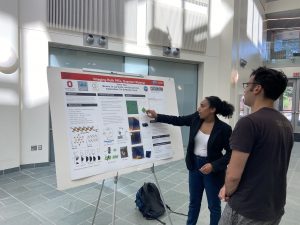 Name: Samra Tekle
Undergraduate Institution: California State University Long Beach
Major: Physics and Mechanical Engineering
REU Advisor: Jay Gupta
Project Title: Imaging Bulk PtTe2 Quantum Material
Abstract: PtTe2, also known as Platinum Ditelleride, is a metallic manmade crystalline solid with a hexagonal crystal structure. PtTe2 is not widely studied, which has left a gap in the literature. However, further research into this material may yield more uses for it in the future. The samples used in these experiments were grown by the Goldberger lab. The PtTe2 samples were imaged under an Atomic Force Microscope (AFM) and a ScanningTunneling Microscope (STM) in order to understand the surface topography at the atomic level. These images were analyzed through Gwyddion.
Name: Samra Tekle
Undergraduate Institution: California State University Long Beach
Major: Physics and Mechanical Engineering
REU Advisor: Jay Gupta
Project Title: Imaging Bulk PtTe2 Quantum Material
Abstract: PtTe2, also known as Platinum Ditelleride, is a metallic manmade crystalline solid with a hexagonal crystal structure. PtTe2 is not widely studied, which has left a gap in the literature. However, further research into this material may yield more uses for it in the future. The samples used in these experiments were grown by the Goldberger lab. The PtTe2 samples were imaged under an Atomic Force Microscope (AFM) and a ScanningTunneling Microscope (STM) in order to understand the surface topography at the atomic level. These images were analyzed through Gwyddion.
 Name: Mark Yaseen
Undergraduate Institution: The Ohio State University
Major: Chemical Engineering
REU Advisor: Shiyu Zhang
Project Title: DAT as an Organic and Renewable Cathode Material for Aqueous Zn-ion Batteries
Abstract: Zinc-ion Battery (ZIB) research has been a growing area of interest, specifically studies exploring the use of organic compounds as cathode material in aqueous zinc-ion batteries (AZIBs). However, several difficulties still inhibit the growth and commercialization of AZIBs, specifically poor electrochemical performance and dissolution of cathode active material. This study synthesized 1,2,4,5-Tetrazine-3,6-diamine (DAT) and utilized its high theoretical capacity of 479 mAh g-1 as a strong foundation for electrochemical performance. Furthermore, to better understand how to prevent dissolution of small organic molecules like DAT, we utilized engineering modifications and observed performance changes in galvanostatic cycling experiments as a result. Our initial findings show that DAT is a viable redox moiety for AZIBs and we provide insight into how engineering design principles can be applied to prevent dissolution of organic cathode materials.
Name: Mark Yaseen
Undergraduate Institution: The Ohio State University
Major: Chemical Engineering
REU Advisor: Shiyu Zhang
Project Title: DAT as an Organic and Renewable Cathode Material for Aqueous Zn-ion Batteries
Abstract: Zinc-ion Battery (ZIB) research has been a growing area of interest, specifically studies exploring the use of organic compounds as cathode material in aqueous zinc-ion batteries (AZIBs). However, several difficulties still inhibit the growth and commercialization of AZIBs, specifically poor electrochemical performance and dissolution of cathode active material. This study synthesized 1,2,4,5-Tetrazine-3,6-diamine (DAT) and utilized its high theoretical capacity of 479 mAh g-1 as a strong foundation for electrochemical performance. Furthermore, to better understand how to prevent dissolution of small organic molecules like DAT, we utilized engineering modifications and observed performance changes in galvanostatic cycling experiments as a result. Our initial findings show that DAT is a viable redox moiety for AZIBs and we provide insight into how engineering design principles can be applied to prevent dissolution of organic cathode materials.
